Cloudy Region Drought Index (CRDI) Based on Long-Time-Series Cloud Optical Thickness (COT) and Vegetation Conditions Index (VCI): A Case Study in Guangdong, South Eastern China
Abstract
:1. Introduction
2. Materials and Methods
2.1. Study Area
2.2. Data Source
3. Methodology
3.1. Calculate VCI and ADI
3.2. Correlation between VCI and ADI
3.3. Estimation Method of Cloudy Pixel
4. Results
4.1. Analysis of VCI Efficiency
4.2. Analysis of Parameters
4.3. Effectiveness Analysis of Filling
4.4. Rational Analysis of the Estimated Value
4.5. Continuity Analysis of CRDI
4.6. Comparison of Spatial Distribution Between CRDI and VCI
5. Discussion
5.1. The Estimation of Extremum Value
5.2. The Influence of Continuous Loss of CRDI
5.3. A Large Number of Data Missing Periods
5.4. Evaluation of CRDI and Future Research Directions
- The accuracy of basic data needs to be improved. The spatial resolution of VCI and COT is 250 m and 1 degree, respectively, COT should be resampled to 250 m. In the follow-up study, higher resolution data can be considered. The accuracy of the estimation results depends on the precision of land use/land cover data. In order to improve the accuracy, more precise land use/land cover data can be considered.
- The effect of the CRDI model in small area may be better. In calculating the parameters of the regression equation, all the pixels without missing data are used, and then the values of all missing pixels are estimated with the obtained parameters. Therefore, the intra class differences of different land cover type in the study area will affect the results of the model. The smaller the study area is, the smaller the intra class differences of different land cover type may be. Therefore, the parameters obtained are more representative of the study area. Therefore, the algorithm of the model can be improved. For example, an n × n window can be opened with the target pixel as the center, and the parameters of the model can be calculated according to the data in the window, and then the drought value of the target pixel can be estimated. However, this improvement has higher requirements for the running efficiency of the algorithm, and the running efficiency of the algorithm should also be considered. Furthermore, how to determine the size of window is also a difficult problem.
6. Conclusions
- The filling efficiency of CRDI is high. CRDI can fill most of the missing data. The average filling efficiency of total data, forest, forest grass mixed and agricultural was as high as 98.0%, 99.1%, 97.5% and 99.5%. Even for the most inefficient periods, 80% were filled.
- The estimated value of CRDI is reasonable. The range distribution of CRDI and its corresponding original VCI is similar, and the estimated value is also within a reasonable range. However, the estimated value is more concentrated than the corresponding previous and the same period data, and the estimation of extreme value is not as accurate as others.
- The continuity of CRDI is quite good. The continuity of CRDI data is analyzed from the perspective of space and time by comparison section line and sample points. The trend of the section line between the current CRDI and the previous CRDI is very similar, and it is reasonable for CRDI to fill the missing areas. The trend of the CRDI curve of sample points is similar to that of the same period, and the continuity of estimated data is better than that of previous and next curve. Considering both time and space, the CRDI model has good continuity. In addition, by comparing the spatial distribution of CRDI and VCI, it is found that the estimated values have good continuity with the surrounding drought values.
Author Contributions
Funding
Acknowledgments
Conflicts of Interest
References
- Wang, J.S.; Li, Y.H.; Wang, R.Y.; Feng, J.; Zhao, Y. Preliminary Analysis on the Demand and Review of Progress in the Field of Meteorological Drought Research. J. Arid Meteorol. 2012, 30, 497–508. [Google Scholar]
- Yuan, W.P.; Zhou, G.S. Comparison Between Standardized Precipitation Index and Z-index in China. Chin. J. Plant Ecol. 2004, 28, 523–529. [Google Scholar]
- Bulut, B.; Tugrul, Y.M.; Cosh, M.H.; Mladenova, I. Quality control of station-based soil moisture observations in Turkey. In Proceedings of the Agu Fall Meeting, San Francisco, CA, USA, 14–18 December 2015. [Google Scholar]
- Ford, T.; McRoberts, D.B.; Quiring, S.M.; Hall, R.E. On the Utility of In-Situ Soil Moisture Observations for Flash Drought Early Warning in the Central United States. In Proceedings of the Agu Fall Meeting, San Francisco, CA, USA, 14–18 December 2015. [Google Scholar]
- Sehgal, V.; Sridhar, V.; Tyagi, A. Stratified drought analysis using a stochastic ensemble of simulated and in-situ soil moisture observations. J. Hydrol. 2017, 545, 226–250. [Google Scholar] [CrossRef] [Green Version]
- Xu, Y.P.; Wang, L.; Ross, K.W.; Liu, C.; Betcrry, K. Standardized Soil Moisture Index for Drought Monitoring Based on Soil Moisture Active Passive Observations and 36 Years of North American Land Data Assimilation System Data: A Case Study in the Southeast United States. Remote Sens. 2018, 10, 301. [Google Scholar] [CrossRef] [Green Version]
- Mihajlović, D. Monitoring the 2003–2004 meteorological drought over Pannonian part of Croatia. Int. J. Climatol. 2006, 26, 2213–2225. [Google Scholar] [CrossRef]
- Mirabbasi, R.; Anagnostou, E.N.; Fakheri-Fard, A.; Dinpashoh, Y.; Etcslamian, S. Analysis of meteorological drought in northwest Iran using the Joint Deficit Index. J. Hydrol. 2013, 492, 35–48. [Google Scholar] [CrossRef]
- Patel, N.R.; Chopra, P.; Dadhwal, V.K. Analyzing spatial patterns of meteorological drought using standardized precipitation index. Meteorol. Appl. 2007, 14, 329–336. [Google Scholar] [CrossRef]
- Yang, S.; Yu, Z.G.; Su, Y. Spatial pattern of meteorological drought in China (1951–2011). J. Arid Land Resour. Environ. 2014, 28, 54–60. [Google Scholar]
- Wang, C.L.; Chen, H.H.; Tang, L.S.; Duan, H. A Daily Meteorological Drought Indicator Based on Standardized Antecedent Precipitation Index and Its Spatial-Temperal Variation. Prog. Inquis. Mutat. Clim. 2012, 8, 157–163. [Google Scholar]
- Cook, E.R.; Jacoby, G.C. Tree-Ring-Drought Relationships in the Hudson Valley, New York. Science 1977, 198, 399–401. [Google Scholar] [CrossRef] [PubMed]
- Huber, K.; Dorigob, W.A.; Bauerc, T.; Eitzinger, J.; Haumann, J.; Kaiser, G.; Linke, R.; Postl, W.; Rischbeck, P.; Schneider, W.; et al. Changes in spectral reflectance of crop canopies due to drought stress. In Proceedings of the 11th SPIE International Symposium on remote Sensing, Vienna, Austria, 20–22 September 2005. [Google Scholar]
- Rigling, A.; Bräker, O.; Schneiter, G.; Schweingruber, F. Intra-annual tree-ring parameters indicating differences in drought stress ofPinus sylvestrisforests within the Erico-Pinion in the Valais (Switzerland). Plant Ecol. 2002, 163, 105–121. [Google Scholar] [CrossRef] [Green Version]
- Tian, Q.; Gou, X.; Zhang, Y.; Peng, J.; Wang, J.; Chen, T. Tree-Ring Based Drought Reconstruction (A.D. 1855–2001) for the Qilian Mountains, Northwestern China. Tree-Ring Res. 2007, 63, 27–36. [Google Scholar] [CrossRef]
- Lloret, F.; Lobo, A.; Estevan, H.; Maisongrande, P.; Vayreda, J.; Terradas, J. Woody plant richness and ndvi response to drought events in catalonian (northeastern Spain) forests. Ecology 2007, 88, 2270–2279. [Google Scholar] [CrossRef]
- Peters, A.J.; WalterShea, E.; Ji, L.; Viña, A. Drought monitoring with NDVI-based standardized vegetation index. Am. Soc. Photogramm. Remote Sens. 2002, 68, 71–75. [Google Scholar]
- Gu, Y.; Brown, J.F.; Verdin, J.P.; Wardlow, B. A five-year analysis of MODIS NDVI and NDWI for grassland drought assessment over the central Great Plains of the United States. Geophys. Res. Lett. 2007, 34, 06407. [Google Scholar] [CrossRef] [Green Version]
- Gu, Y.; Hunt, E.; Wardlow, B.; Basara, J.B.; Brown, J.F.; Verdin, J.P. Evaluation of MODIS NDVI and NDWI for vegetation drought monitoring using Oklahoma Mesonet soil moisture data. Geophys. Res. Lett. 2008, 35, 22401. [Google Scholar] [CrossRef] [Green Version]
- Wang, L.; Qu, J.J. NMDI: A normalized multi-band drought index for monitoring soil and vegetation moisture with satellite remote sensing. Geophys. Res. Lett. 2007, 34, L20405. [Google Scholar] [CrossRef]
- Wang, L.; Qu, J.J.; Hao, X. Forest fire detection using the normalized multi-band drought index (NMDI) with satellite measurements. Agric. For. Meteorol. 2008, 148, 1767–1776. [Google Scholar] [CrossRef]
- Patel, N.R.; Parida, B.R.; Venus, V.; Saha, S.K.; Dadhwal, V.K. Analysis of agricultural drought using vegetation temperature condition index (VTCI) from Terra/MODIS satellite data. Environ. Monit. Assess. 2012, 184, 7153–7163. [Google Scholar] [CrossRef] [PubMed]
- Sun, W.; Wang, P.-X. Further studies on vegetation temperature condition index drought-monitoring model using AVHRR data. Int. Soc. Opt. Eng. 2005, 5884, 58840F. [Google Scholar]
- Qian, X.; Liang, L.; Shen, Q.; Sun, Q.; Zhang, L.; Liu, Z.; Zhao, S.; Qin, Z. Drought trends based on the VCI and its correlation with climate factors in the agricultural areas of China from 1982 to 2010. Environ. Monit. Assess. 2016, 188, 639. [Google Scholar] [CrossRef]
- Kogan, F.N. Droughts of the Late 1980s in the United States as Derived from NOAA Polar-Orbiting Satellite Data. Bull. Am. Meteorol. Soc. 1995, 76, 655–668. [Google Scholar] [CrossRef] [Green Version]
- Kogan, F. Application of vegetation index and brightness temperature for drought detection. Adv. Space Res. 1995, 15, 91–100. [Google Scholar] [CrossRef]
- Wang, P.-X.; Li, X.-W.; Gong, J.-Y.; Song, C. Vegetation-temperature condition index and its application for drought monitoring. Editor. Board Geomat. Inf. Sci. Wuhan Univ. 2001, 26, 412–418. [Google Scholar]
- Quiring, S.M.; Ganesh, S. Evaluating the utility of the Vegetation Condition Index (VCI) for monitoring meteorological drought in Texas. Agric. For. Meteorol. 2010, 150, 330–339. [Google Scholar] [CrossRef]
- Liu, L.M. The Research of Remote Sensing Drought Prediction Model Based on EOS MODIS Data; Wuhan University: Wuhan, China, 2004. [Google Scholar]
- Tan, D.B.; Liu, L.M.; Yan, J.J. Research on drought monitoring model based on MODIS data. J. Yangtze River Sci. Res. Inst. 2004, 21, 11–15. [Google Scholar]
- Liu, J.; Zhang, W.J.; Zhu, Y.J. Case Study on Cloud Properties of Heavy Rainfall Based upon Satellite Data. J. Appl. Meteorol. Sci. 2007, 18, 158–164. [Google Scholar]
- Kobayashi, T.; Masuda, K. Changes in Cloud Optical Thickness and Cloud Drop Size Associated with Precipitation Measured with TRMM Satellite. J. Meteorol. Soc. Jpn. 2009, 87, 593–600. [Google Scholar] [CrossRef] [Green Version]
- Kobayashi, T.; Masuda, K. Effects of precipitation on cloud optical thickness derived from combined passive and active space-borne sensors. AIP Conf. Proc. 2009, 1100, 267–270. [Google Scholar]
- Wang, J. Spatial and Temporal Variation of Eco-Environment of Rice Planting Areas in Guangdong Province and Its Comprehensive Evaluation; South China Agricultural University: Guangzhou, China, 2018. [Google Scholar]
- He, Q.J.; Cao, J.; Zhang, Y.W. Establishment and Application of Vegetation Index Sequences in Guangdong Based on MODIS Data. Meteorol. Mon. 2008, 34, 37–41. [Google Scholar]
- Fu, C.B.; Dan, L.; Feng, J.M. Temporal and Spatial Variations of Total Cloud Amount and Their Possible Relationships with Temperature and Water Vapor over China during 1960 to 2012. Chin. J. Atmos. Sci. 2019, 41, 87–98. [Google Scholar]
- Li, W.J.; Wang, Y.P. Analysis of the Spatial-Temporal Characteristics of Drought in Guangdong based on Vegetation Condition Index from 2003 to 2017. J. South China Norm. Univ. (Nat. Sci. Ed.) 2020, 52, 85–91. [Google Scholar]
- Rouse, J.W.; Hass, R.H.; Schell, J.A.; Deering, D.W. Monitoring Vegetation Systems in the Great Plains with ERTS. NASA Spec. Publ. 1974, 1, 309–317. [Google Scholar]
- Kogan, F.N. Remote sensing of weather impacts on vegetation in non-homogeneous areas. Int. J. Remote Sens. 1990, 11, 1405–1419. [Google Scholar] [CrossRef]
- Liang, L.; Sun, Q.; Luo, X.; Wang, J.; Zhang, L.; Deng, M.; Di, L.; Liu, Z. Long-term spatial and temporal variations of vegetative drought based on vegetation condition index in China. Ecosphere 2017, 8, e01919. [Google Scholar] [CrossRef]
- Shen, Q.; Liang, L.; Luo, X.; Li, Y.; Zhang, L. Analysis of the spatial-temporal variation characteristics of vegetative drought and its relationship with meteorological factors in China from 1982 to 2010. Environ. Monit. Assess. 2017, 189, 471. [Google Scholar] [CrossRef] [PubMed]
- Gong, Z.J.; Liu, L.M.; Chen, J. Phenophase Extraction of Spring Maize in Liaoning Province Based on MODIS NDVI Data. J. Shenyang Agric. Univ. 2018, 49, 257–265. [Google Scholar]
- Eilers, P.H. A perfect smoother. Anal. Chem. 2003, 75, 3631. [Google Scholar] [CrossRef]
- Li, J.; Zhu, H. The Reconstruction of MODIS/NDVI Time Series Data in Chongqing. Sci. Geogr. Sin. 2017, 37, 437–444. [Google Scholar]
- Zhu, H.; Li, J. Three Timed-Series NDVI Reconstruction Methods: A Case Study of Chongqing. Mt. Res. 2014, 47, 2998–3008. [Google Scholar]
- Zhang, H.; Ren, Z.Y. Comparison and Application Analysis of Several NDVI Time-Series Reconstruction Methods. Sci. Agric. Sin. 2014, 47, 2998–3008. [Google Scholar]
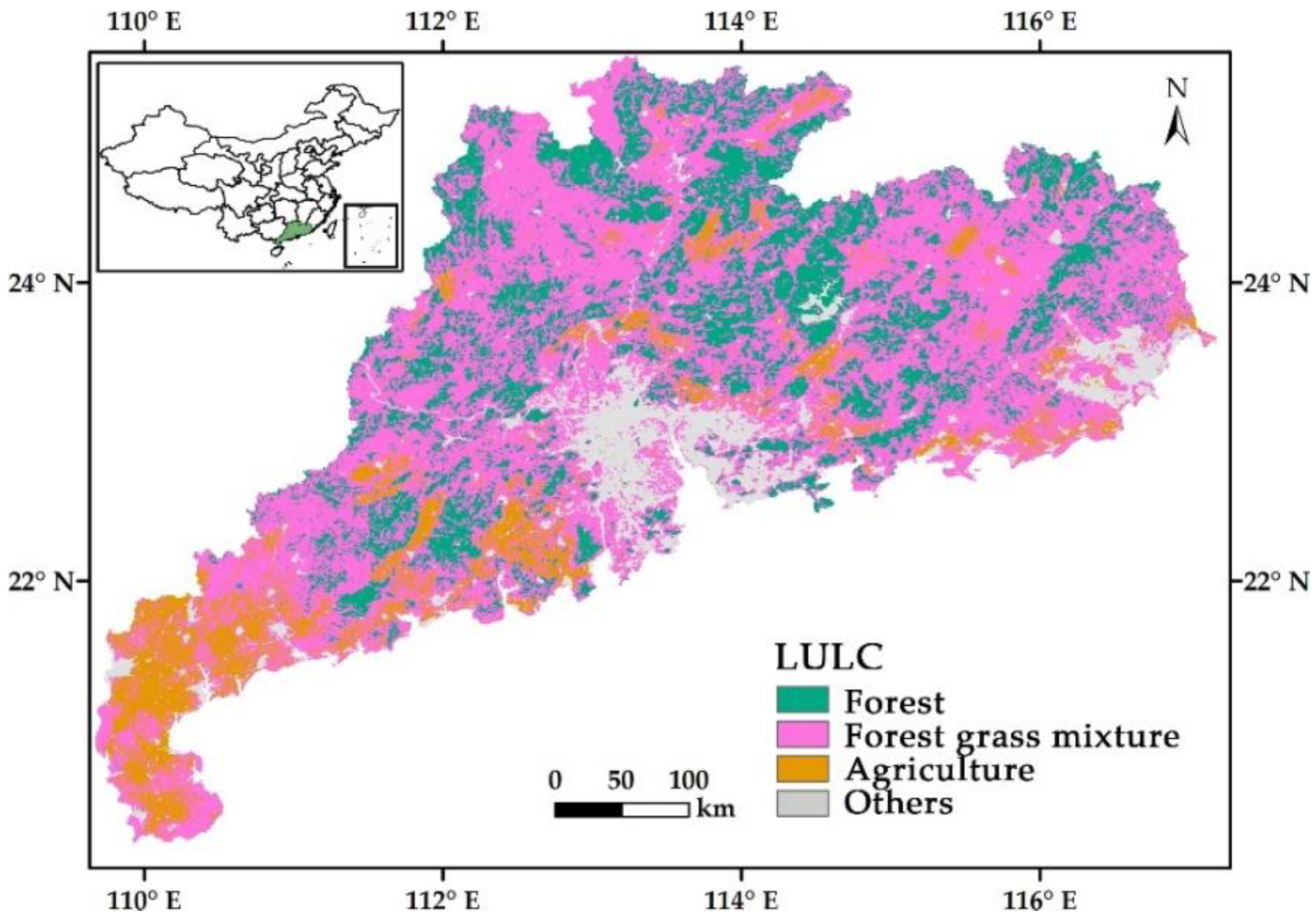

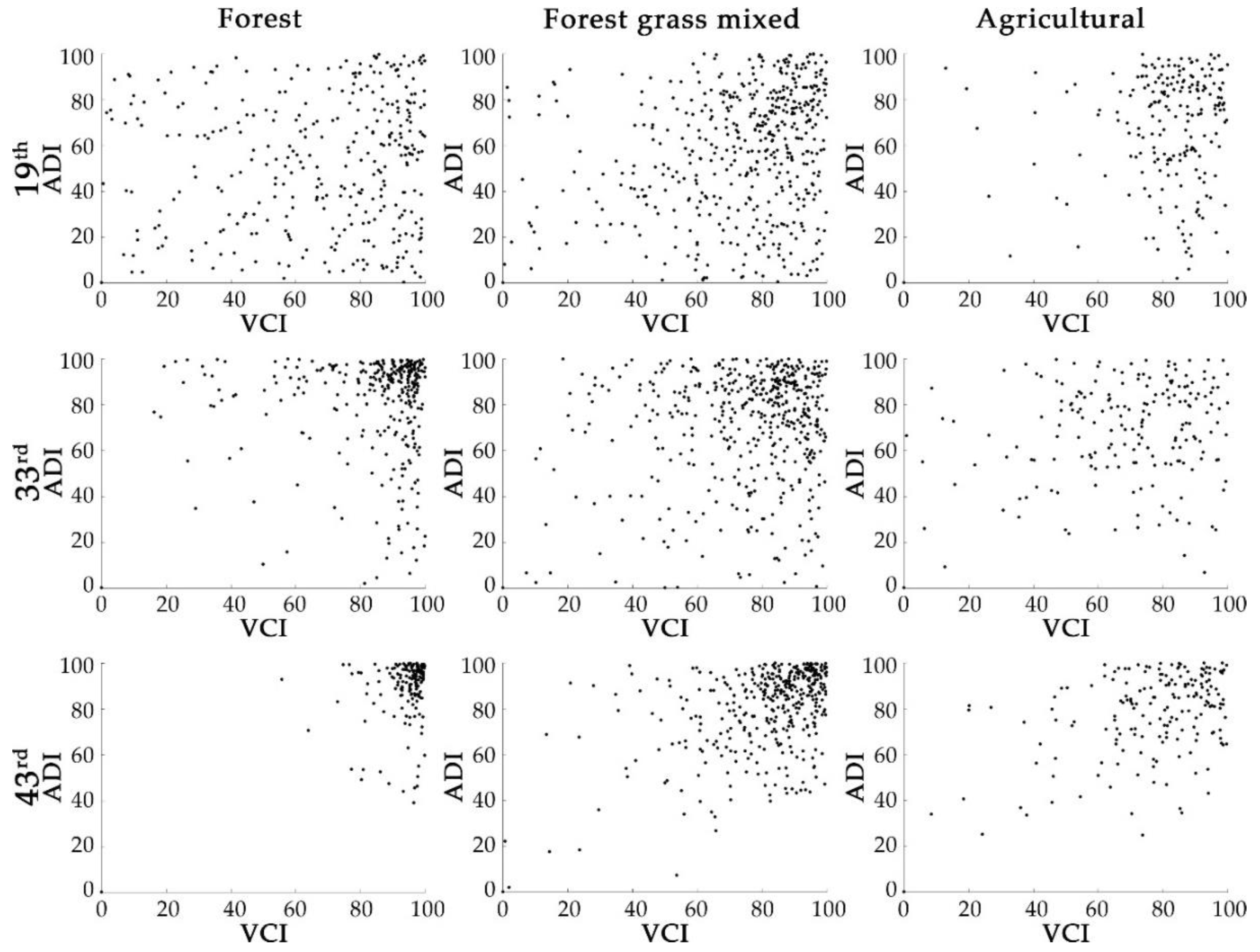
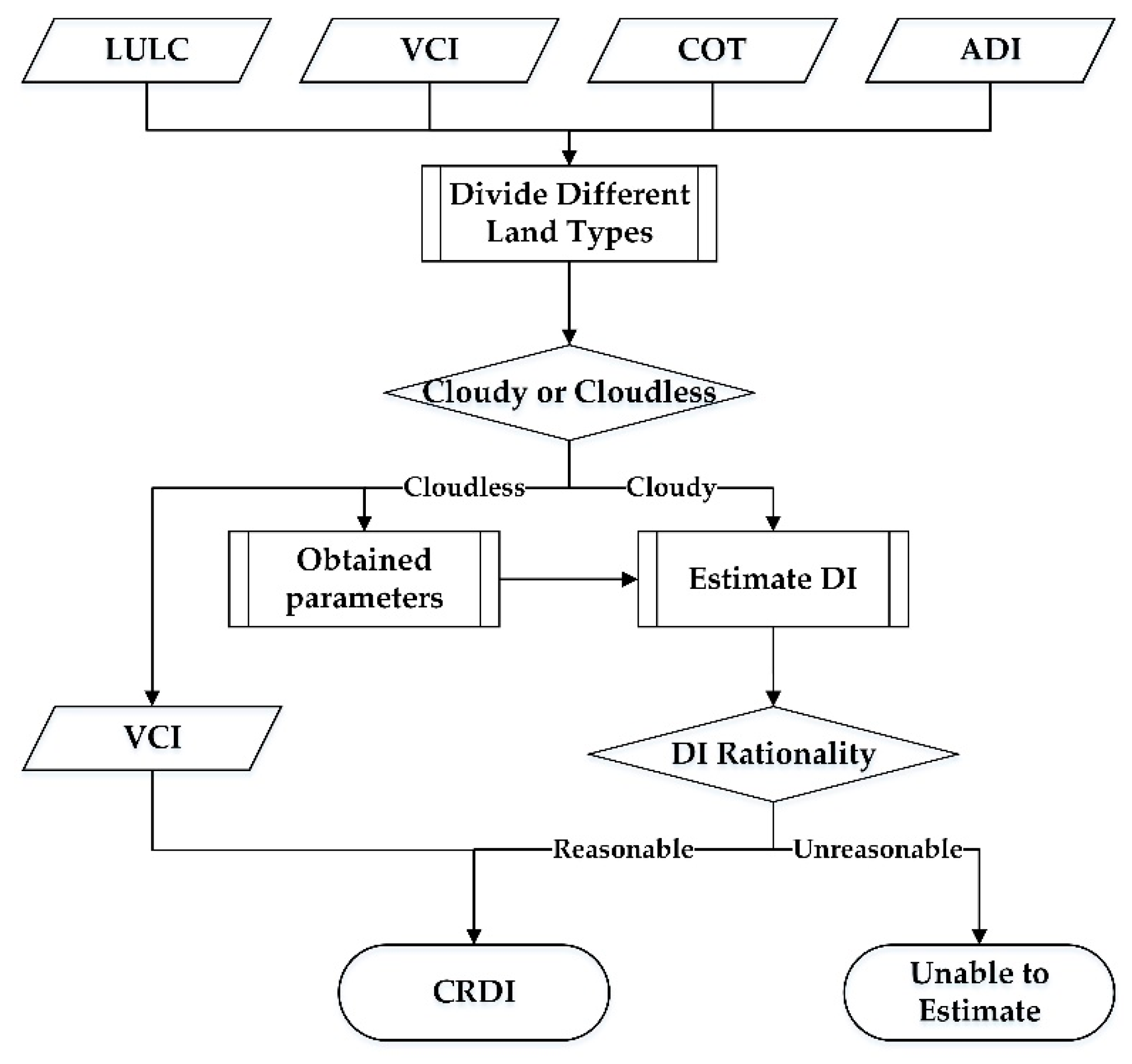

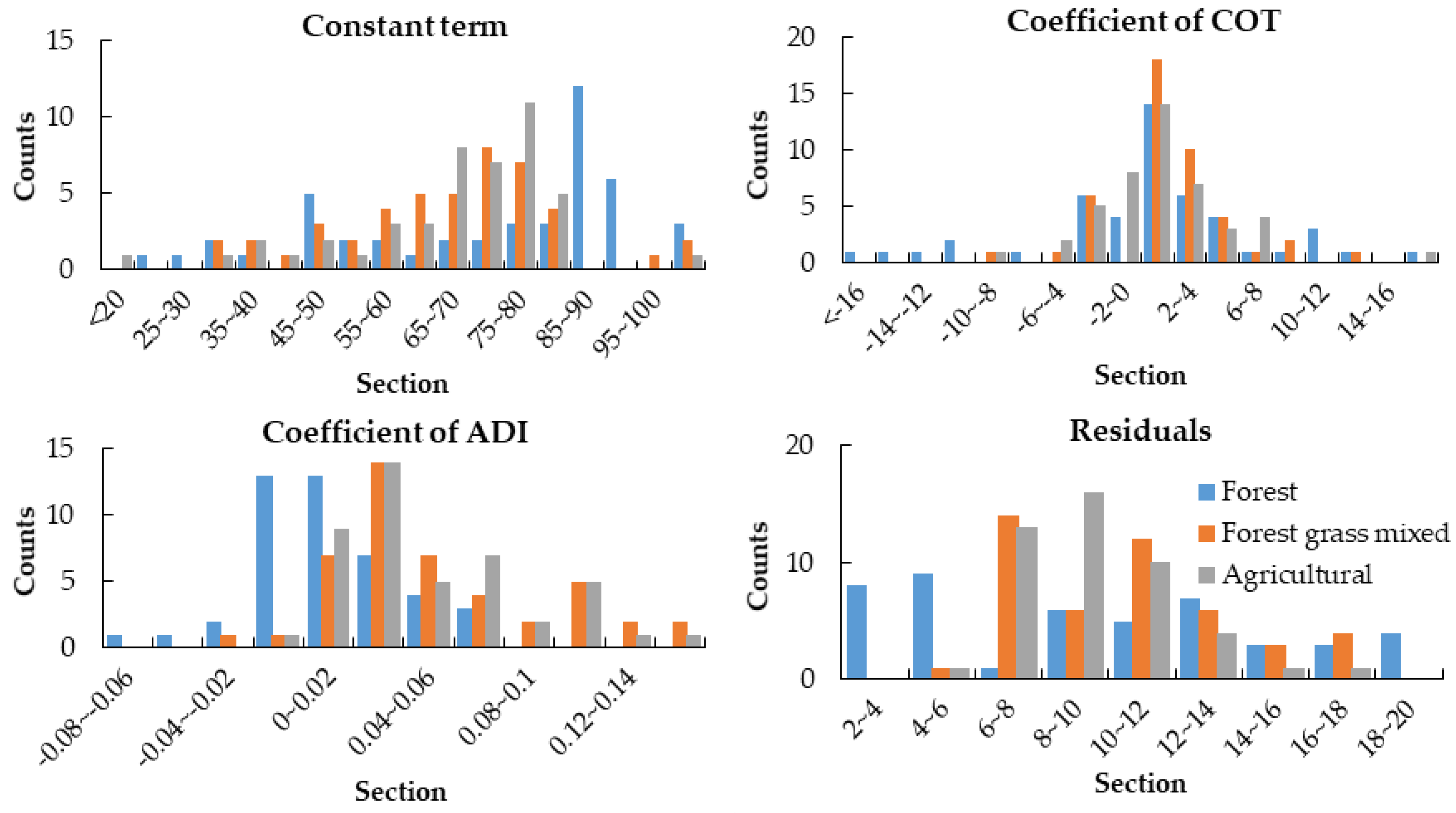

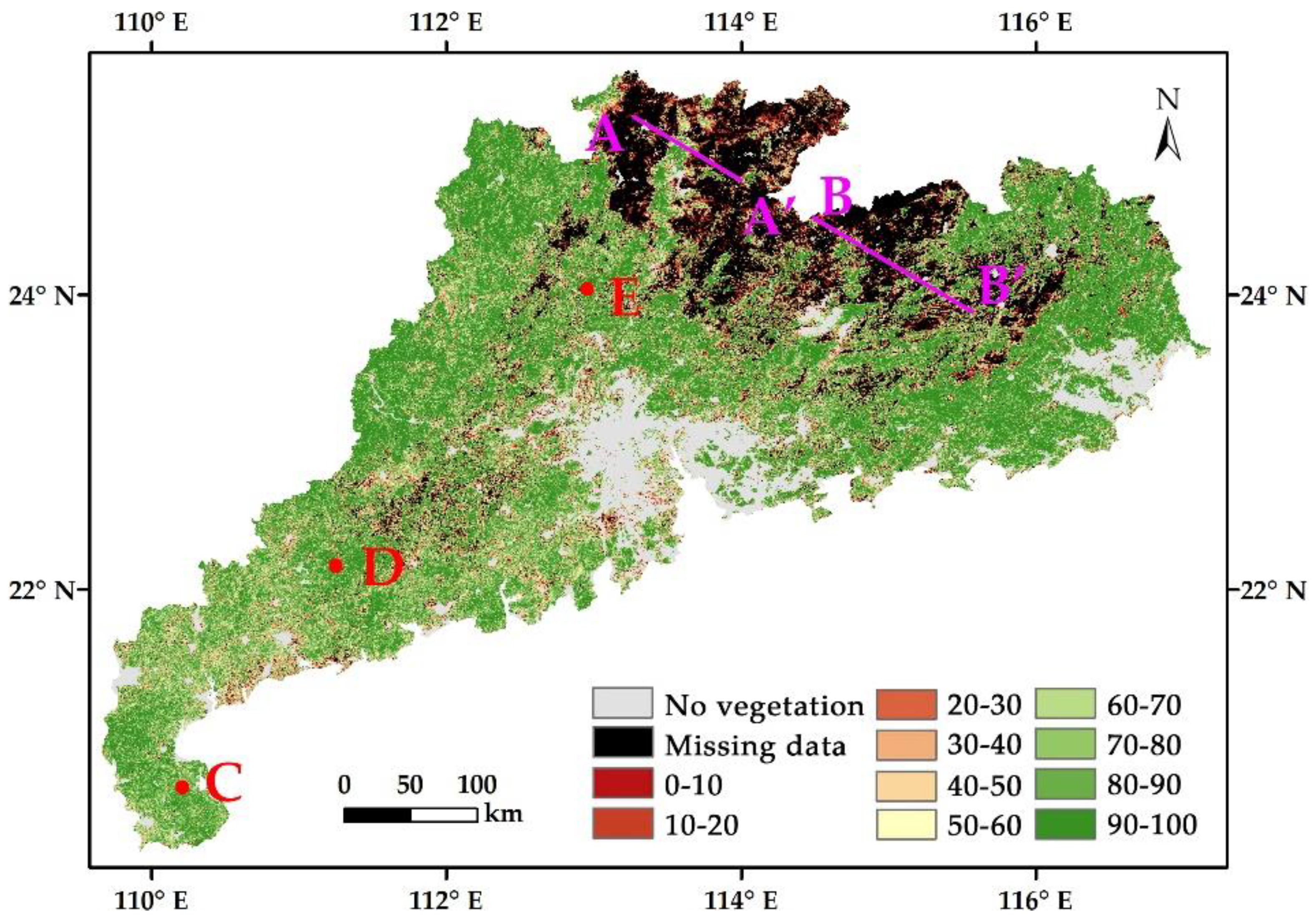


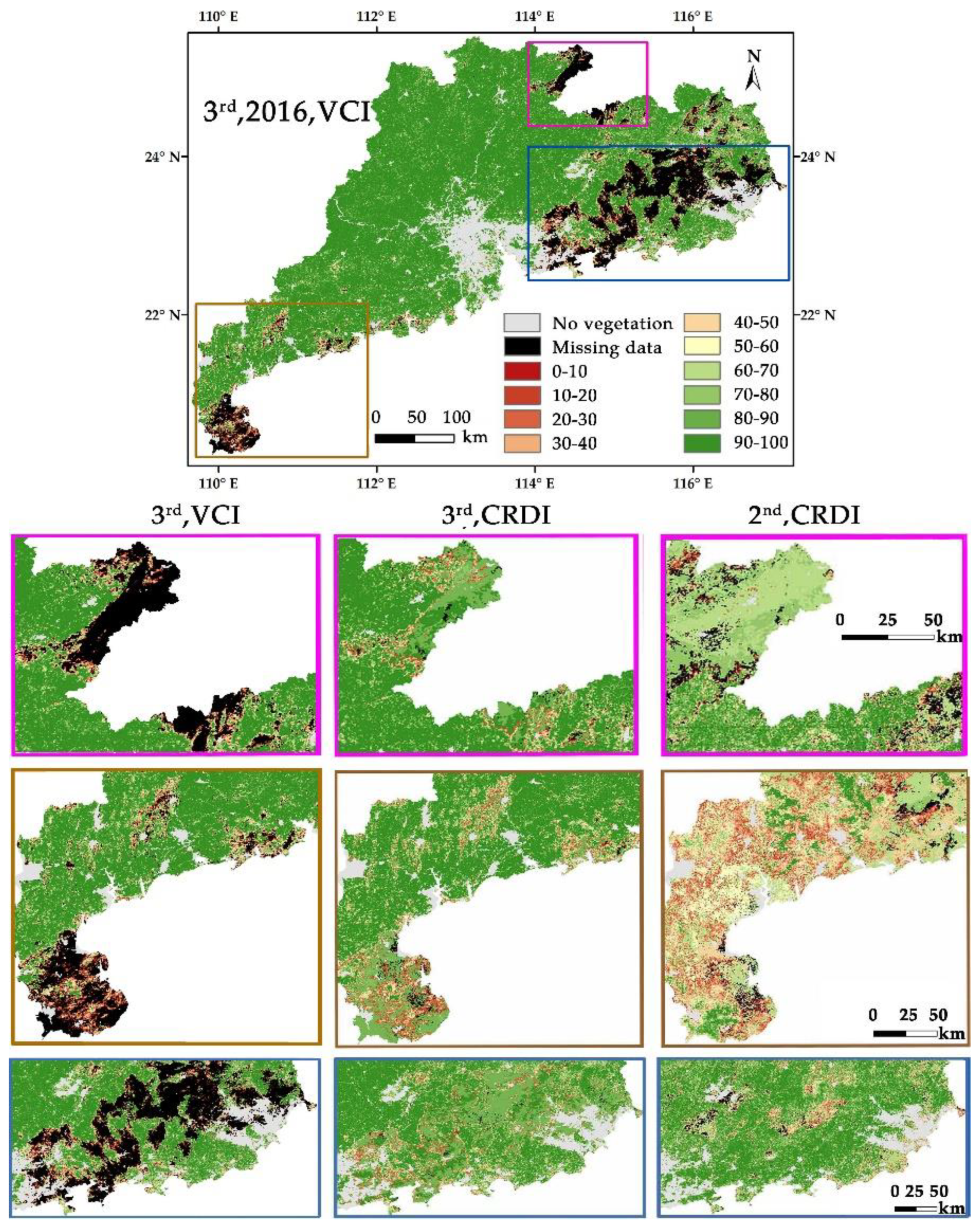

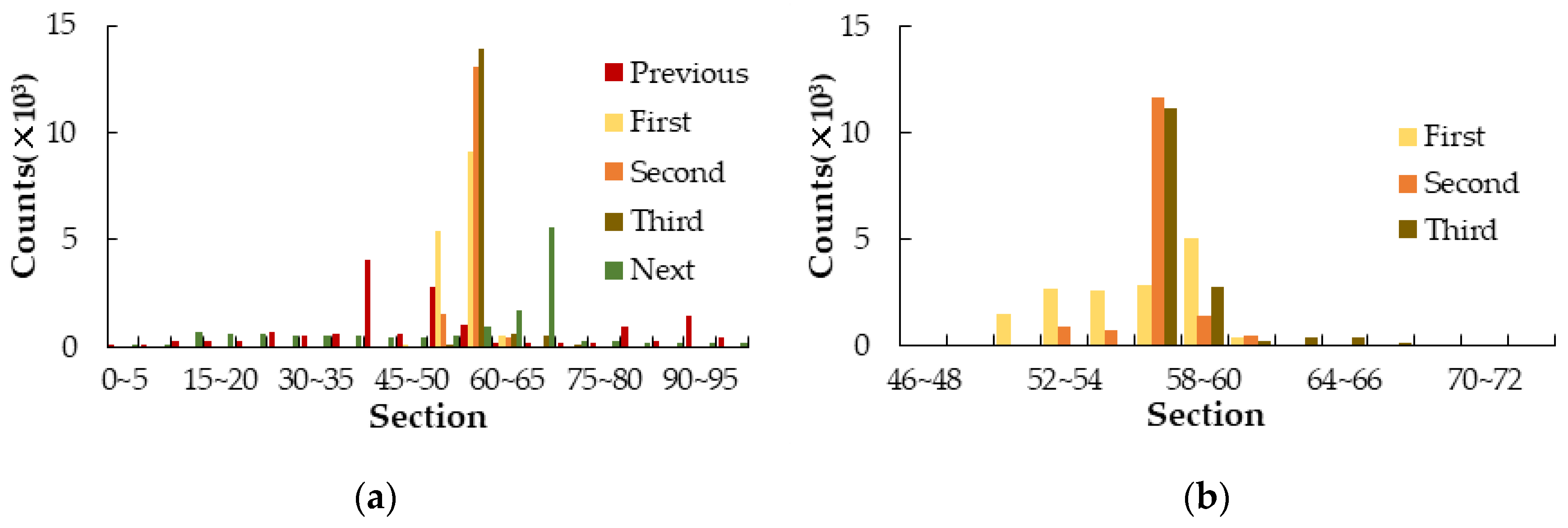
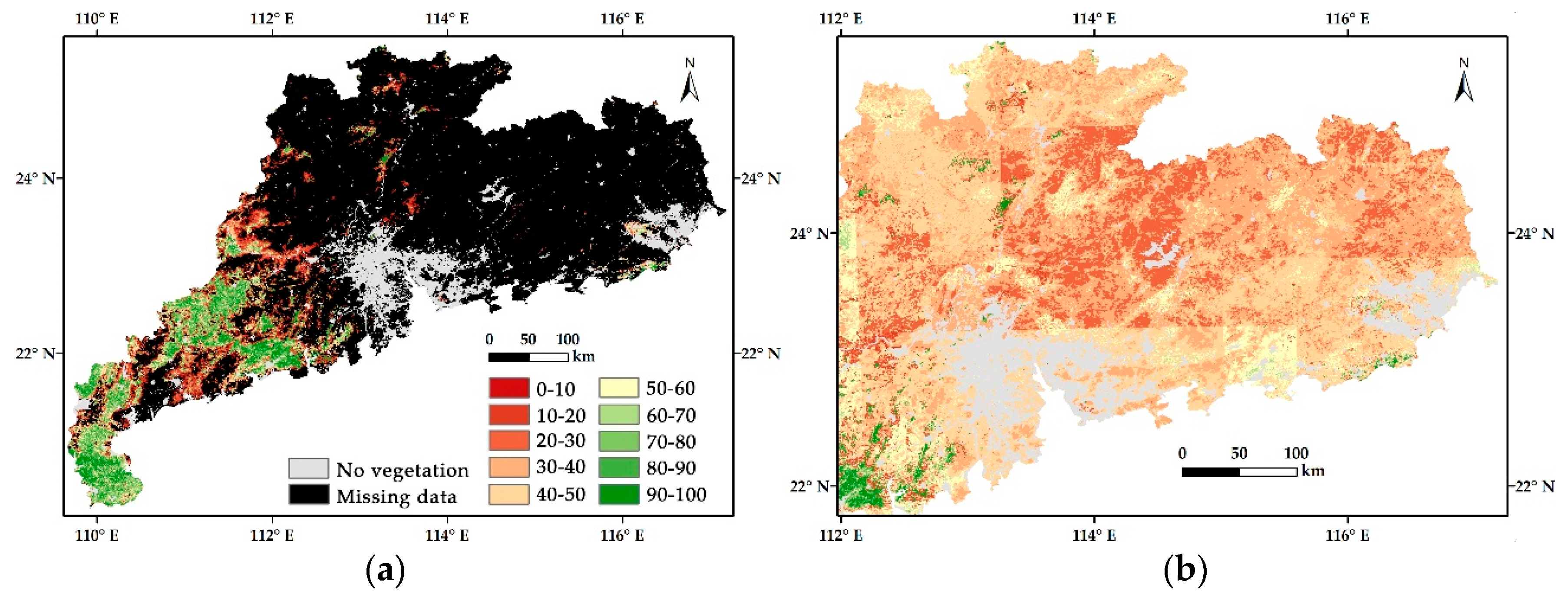
| Category | Proportion (%) | Category Corresponding to IGBP |
|---|---|---|
| Forest | 21.59 | broad-leaved evergreen forests, evergreen coniferous forest, deciduous broad leaved forest, deciduous coniferous forest, mixed forest, closed shrubbery, sparse shrubbery. |
| Forest grass mixed | 58.99 | forested grassland, savanna, grassland. |
| Agricultural | 9.72 | farmland, farmland and natural vegetation mosaic. |
| No vegetation | 9.7 | permanent wetland, water body, bare land, ice and snow. |
| Statistic | Land Type | Constant Term | Coefficient of COT | Coefficient of ADI | Average Residual | Absolute Residual | p Value |
|---|---|---|---|---|---|---|---|
| Average | Forest | 74.55 | 0.32 | 0.02 | 0.00 | 9.61 | 0.00 |
| Forest grass mixed | 68.01 | 0.54 | 0.06 | 0.00 | 10.26 | 0.00 | |
| Agricultural | 67.43 | 0.72 | 0.06 | 0.00 | 9.34 | 0.00 | |
| Median | Forest | 82.68 | 1.04 | 0.01 | 0.00 | 9.83 | 0.00 |
| Forest grass mixed | 69.59 | 1.72 | 0.05 | 0.00 | 10.20 | 0.00 | |
| Agricultural | 70.71 | 0.72 | 0.04 | 0.00 | 9.32 | 0.00 | |
| Variance | Forest | 676.83 | 68.50 | 0.00 | 0.00 | 26.12 | 0.00 |
| Forest grass mixed | 372.26 | 42.98 | 0.00 | 0.00 | 9.84 | 0.00 | |
| Agricultural | 272.18 | 23.62 | 0.00 | 0.00 | 5.41 | 0.00 | |
| Standard Deviation | Forest | 26.30 | 8.37 | 0.03 | 0.00 | 5.17 | 0.00 |
| Forest grass mixed | 19.52 | 6.63 | 0.04 | 0.00 | 3.17 | 0.00 | |
| Agricultural | 16.68 | 4.91 | 0.04 | 0.00 | 2.35 | 0.00 |
| Filling Efficiency | Total | Forest | Forest Grass Mixed | Agricultural |
|---|---|---|---|---|
| Over 98% | 31 | 41 | 28 | 42 |
| 95~98% | 10 | 2 | 12 | 3 |
| 90~95% | 3 | 1 | 4 | 1 |
| 85~90% | 1 | 1 | 1 | 0 |
| 80~85% | 1 | 1 | 1 | 0 |
Publisher’s Note: MDPI stays neutral with regard to jurisdictional claims in published maps and institutional affiliations. |
© 2020 by the authors. Licensee MDPI, Basel, Switzerland. This article is an open access article distributed under the terms and conditions of the Creative Commons Attribution (CC BY) license (http://creativecommons.org/licenses/by/4.0/).
Share and Cite
Li, W.; Wang, Y.; Yang, J. Cloudy Region Drought Index (CRDI) Based on Long-Time-Series Cloud Optical Thickness (COT) and Vegetation Conditions Index (VCI): A Case Study in Guangdong, South Eastern China. Remote Sens. 2020, 12, 3641. https://doi.org/10.3390/rs12213641
Li W, Wang Y, Yang J. Cloudy Region Drought Index (CRDI) Based on Long-Time-Series Cloud Optical Thickness (COT) and Vegetation Conditions Index (VCI): A Case Study in Guangdong, South Eastern China. Remote Sensing. 2020; 12(21):3641. https://doi.org/10.3390/rs12213641
Chicago/Turabian StyleLi, Weijiao, Yunpeng Wang, and Jingxue Yang. 2020. "Cloudy Region Drought Index (CRDI) Based on Long-Time-Series Cloud Optical Thickness (COT) and Vegetation Conditions Index (VCI): A Case Study in Guangdong, South Eastern China" Remote Sensing 12, no. 21: 3641. https://doi.org/10.3390/rs12213641






